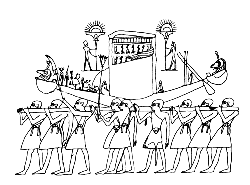
A statement made by a god, sometimes spontaneously but usually after being presented with a question. Although the custom is undoubtedly older, the first clear sources about oracles date from the New Kingdom and only after the 20th Dynasty is there more substantial information. In the 21st Dynasty in particular, the oracle was more frequently consulted. At that time, too, the 'festival of the oracle' was celebrated in the courtyard between the 9th and 10th pylons of the temple of Karnak. The Egyptians were looking for answers from the oracle to a wide range of questions, usually referring to the future. Sometimes these were of great importance. Various kings, for example Hatshepsut, Tuthmosis III and Herihor, have recorded in the temples that the god had chosen them as the next ruler, in order to legitimize their rule. The god was also consulted before going into battle on occasions of war or foreign rebellion. Just like the king, priests too, the servants of the god, could be chosen by means of the oracle. In a similar way high officials sought approval for their deeds. All kinds of situations and problems from daily life were also presented to the oracle, such as questions concerning marriage, illness, possessions, approval of wills or the disclosure of the name of a thief. Sometimes the oracle was consulted when the parties were unwilling or unable to lay the case before the courts. One hieratic text has survived which documents a case of theft being presented to the oracle because the suspect was himself a member of the law court. Some questions were presented several times, sometimes to different oracles. An instance is known of a thief who was found guilty by the first oracle but still wanted to prove his innocence. A question could be put to various gods. For most of Egyptian history, Amun was by far and away the most popular and thus the most consulted god. But in Deir el-Medinah, for example, the favourite was the deified king Amenhotep I, patron of the area. The most usual way of consulting the oracle was to present questions at the moment that the god was being carried in his bark outside the temple during processions. The answer was interpreted from the movements of the god (nodding or leaning backwards). No movement meant rejection. In order to differentiate the latter from 'no answer', the god was first asked whether he was willing to answer. The method of consultation demanded that questions be so formulated that they could be answered by 'yes' or 'no'. Questions were sometimes put verbally, but also laid in written form along the route in order to prevent the priests carrying the statue from hearing the question and influencing the answer. There are also a number of instances where the nature of the oracle in fact assumes that the god will give a more detailed answer; texts also suggest that the god actually spoke. Nevertheless, the interpretation of these sources is still under discussion. From Roman times we know of a type of oracle whereby the voice of a hidden priest echoed through a pipe. It is assumed that the oracle in the Siwa Oasis which proclaimed Alexander the Great the son of the god was orchestrated by a priest hidden in a different room listening to the questions. A god could also disclose his wishes in a dream. Thus Tuthmosis IV dreamt that he must free the Sphinx at Giza from the sand drifts. In the Late Period and later, the custom appears to have been to sleep within the walls of certain temples, so that the god could give an oracle in the form of a dream. Many dream texts, often interpretative, usually in Greek or Demotic, have been found. In the 3rd Intermediate Period appeared a type of amulet designed to protect the wearer against all evil. It contained a written decree which stated that it had been issued by the god in the form of an oracle.